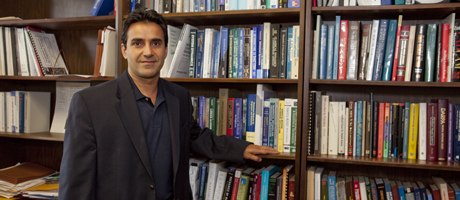By Menachem Wecker
Learner’s permit in hand, Azim Eskandarian’s 16-year-old son is practicing for his driving test. But with an expert on automotive safety for a father, he can expect to overcome some additional hurdles before he receives his first set of keys.
“I’m actually planning to put my children through not only the regular requirements but also specialty maneuver training,” says Dr. Eskandarian, B.S. ’82, D.Sc. ’91, director of GW’s Center for Intelligent Systems Research. “It is an experience you can’t practice on your own.”
However cautious he is with his two children, Dr. Eskandarian, professor of engineering and applied science, proudly notes that he rides a motorcycle—a Yamaha Road Star 1700 to be exact.
He has taken the bike from his home in Great Falls, Va., to downtown Washington a few times, but he mostly rides it for fun, he says. He used to drive a Mercedes but then switched to a Mini (for gas efficiency), and then to a Honda when his family outgrew the Mini.
Just as doctors are often called upon to offer professional advice in social and family gatherings, Dr. Eskandarian says friends and relatives often ask him about automotive safety.
He says 90 percent of accidents are due to intentional or unintentional driver error, so achieving a rate of zero fatalities and reducing the number and severity of injuries is a realistic, though lofty, goal.
“Everyone knows a family who has experienced a crash injury or fatality,” he says. “It’s very tangible research.”
Dr. Eskandarian’s research and publications have been drawing a lot of attention to GW’s engineering programs lately.
According to a recent study in the Institute of Electrical and Electronics Engineers’ journal Intelligent Transportation Systems, which examined all 421 papers and articles published in the journal, papers of Dr. Eskandarian’s were the third and fifth most cited in the journal.
More than 1,000 different authors published in the journal, and of the 457 institutions represented from 36 different countries, GW was the second most cited university.
David Dolling, dean of the School of Engineering and Applied Science, was delighted but not surprised to learn about the study.
“The Center for Intelligent Systems Research, of which Dr. Eskandarian is director, together with the National Crash Analysis Center, are known and respected nationally and internationally for the impact their work has had on a broad array of transportation safety issues,” he says. “Improving transportation safety is the true goal of their research, but we are also very pleased with the recognition they have brought to the school and GW in the process.”
Dr. Eskandarian, who grew up in Iran, came to GW in the late ’70s as a student in his brother’s footsteps. “GW had a very good reputation internationally,” he says. “It still does.” He worked for engineering consulting firms in the Washington area for six years before accepting a position at Penn State University, where he taught from 1989 to 1992. He joined the faculty of GW’s School of Engineering and Applied Science in 1993.
Growing up, Dr. Eskandarian was exposed to mechanical and civil engineering. His father was president of a power company that provided energy for an entire province and, later on, was CEO of a wood factory that imported trees from Indonesia and Southeast Asia and made doors and a variety of other products. “As a child, I was intrigued by how machines worked and operated,” he says.
He says the international and political nature of Washington attracts a lot of students and researchers, and many companies’ research and development laboratories and government-related consulting firms are based in the District. “Washington is a very desirable area for engineers,” he says.
Dr. Eskandarian is currently conducting collision avoidance research, which focuses on intelligent vehicles that can help avoid crashes. Some products that recently hit the market are adaptive cruise control, which uses radar and sensors to automatically slow a car down if it approaches other cars, and a lane departure warning system that alerts the driver if the vehicle zigzags across lanes.
His research on advanced driver assistance systems has included development of control systems for vehicle evasive maneuvers in crash-likely situations, intervehicular communications for safety applications, in-vehicle speed adaptation and compliance systems and unobtrusive methods of detecting driver drowsiness, for which he has a pending patent.
“It seems a little far reaching or futuristic, but I think we can get to the point of autonomous driving or total assistance for the driver, where you indicate where you want to go and the car takes you there safely and efficiently,” he says.


